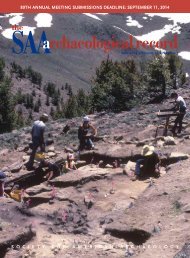SAA
SAA_Record_Nov2015
SAA_Record_Nov2015
You also want an ePaper? Increase the reach of your titles
YUMPU automatically turns print PDFs into web optimized ePapers that Google loves.
PROS AND CONS OF CONSULTING COLLECTORS<br />
Where do we draw the line in our dealing with collectors? I<br />
advocate that we abstain from studying their collections as<br />
much as possible. Certainly there are other more positive<br />
ways for professionals to interact with avocationals. In southern<br />
Oregon, we developed a strong adult-education program,<br />
providing field and laboratory experiences for energetic amateurs<br />
and organizing regular lecture series and weekend<br />
field-study trips. Similarly, as Shott and Pitblado noted in<br />
their introduction to these essays, the U.S. Forest Service<br />
and the BLM have implemented stewardship programs<br />
across the West, enlisting the energy of amateurs in preservation.<br />
In these contexts, the public has become a stakeholder<br />
in the conservation of archaeological sites and artifacts,<br />
taking on a much more meaningful and positive role in<br />
archaeology than artifact collectors ever will. Even in the<br />
eastern U.S., where public land is rare, let’s put our energy<br />
into negotiating with land owners and learning about the<br />
archaeological record first-hand, rather than negotiating<br />
with collectors to learn about the record second-hand.<br />
Paleontologists Do It. Why Can’t We?<br />
The Society of Vertebrate Paleontology has the following<br />
policy for papers published in the Journal of Vertebrate<br />
Paleontology. Section 4 of their Code of Ethics states that<br />
“significant fossil vertebrate specimens, along with ancillary<br />
data, should be curated and accessioned in the collections<br />
of repositories charged in perpetuity with conserving<br />
fossil vertebrates for scientific study and education (e.g.,<br />
accredited museums, universities, colleges and other educational<br />
institutions)” (http://vertpaleo.org/Membership/Member-Ethics/Member-Bylaw-on-Ethics-Statement.aspx).<br />
According to the journal’s senior editor, Dr.<br />
Patrick O’Connor of Ohio University, the journal’s editors<br />
check to ensure that any collections presented in submitted<br />
papers are consistent with this ethics statement.<br />
Authors understand that a violation of this code will lead<br />
to the paper’s rejection. The Society’s reasoning is clear:<br />
vertebrate fossils in private hands can be bought and sold,<br />
and such commerce in vertebrate fossils is inconsistent<br />
with scientific research because “it deprives the public and<br />
professionals of important specimens, which are part of<br />
our natural heritage” (Section 6 of the Society’s ethics<br />
statement).<br />
References Cited<br />
Art Daily<br />
2013 Rutz Clovis Point Sets World Auction Record. Electronic<br />
document, http://artdaily.com/news/66327/Rutz-Clovis-pointsets-world-auction-record-at-Morphy-s—sells-to-Texas-collectorfor—276-000#.VesC7xFViko,<br />
accessed October 7, 2015.<br />
Barker, James P., Cynthia Ellis-Pinto, and David Valentine<br />
2011 Looting at Elephant Mountain Cave. Nevada Archaeologist<br />
24:1–10.<br />
Genz, Michelle<br />
2013 Vero Bone with Ice Age Etching Is Sold to an Out-Of-State<br />
Trust. Vero News.com. Electronic document,<br />
http://www.veronews.com/news/indian_river_county/spotlight/vero-bone-with-ice-age-etching-is-sold-toan/article_bc289b44-91ca-11e2-ada7-0019bb30f31a.html,<br />
accessed October 7, 2015.<br />
Graf, Kelly E., and Nancy H. Bigelow<br />
2011 Human Response to Climate during the Younger Dryas<br />
Chronozone in Central Alaska. Quaternary International<br />
242:434–451.<br />
Potter, Ben A., Charles E. Holmes, and David R. Yesner<br />
2013 Technology and Economy among the Earliest Prehistoric<br />
Foragers in Interior Eastern Beringia. In Paleoamerican Odyssey,<br />
edited by Kelly E. Graf, Caroline V. Ketron, and Michael R.<br />
Waters, pp. 81–104. Center for the Study of the First Americans,<br />
Texas A&M University, College Station.<br />
Purdy, Barbara A., Kevin S. Jones, John J. Mecholsky, Gerald<br />
Bourne, Richard C. Hulbert, Bruce J. MacFadden, Krista L.<br />
Church, Michael W. Warren, Thomas F. Jorstad, Dennis J.<br />
Stanford, Melvin J. Wachowiak, and Robert J. Speakman<br />
2011 Earliest Art in the Americas: Incised Image of a Proboscidean<br />
on a Mineralized Extinct Animal Bone from Vero<br />
Beach, Florida. Journal of Archaeological Science 38:2908–2913.<br />
Rhode, David, Ted Goebel, Kelly Graf, Bryan Hockett, Kevin T.<br />
Jones, David B. Madsen, Charles G. Oviatt, and David N.<br />
Schmitt<br />
2005 Latest Pleistocene-Early Holocene Human Occupation and<br />
Paleoenvironmental Change in the Bonneville Basin, Utah-<br />
Nevada. In Interior Western United States, edited by Joel Pederson<br />
and Carol Dehler, pp. 211–230. Geological Society of America<br />
Field Guide 6. Boulder, Colorado.<br />
—Ted Goebel<br />
32 The <strong>SAA</strong> Archaeological Record • November 2015




